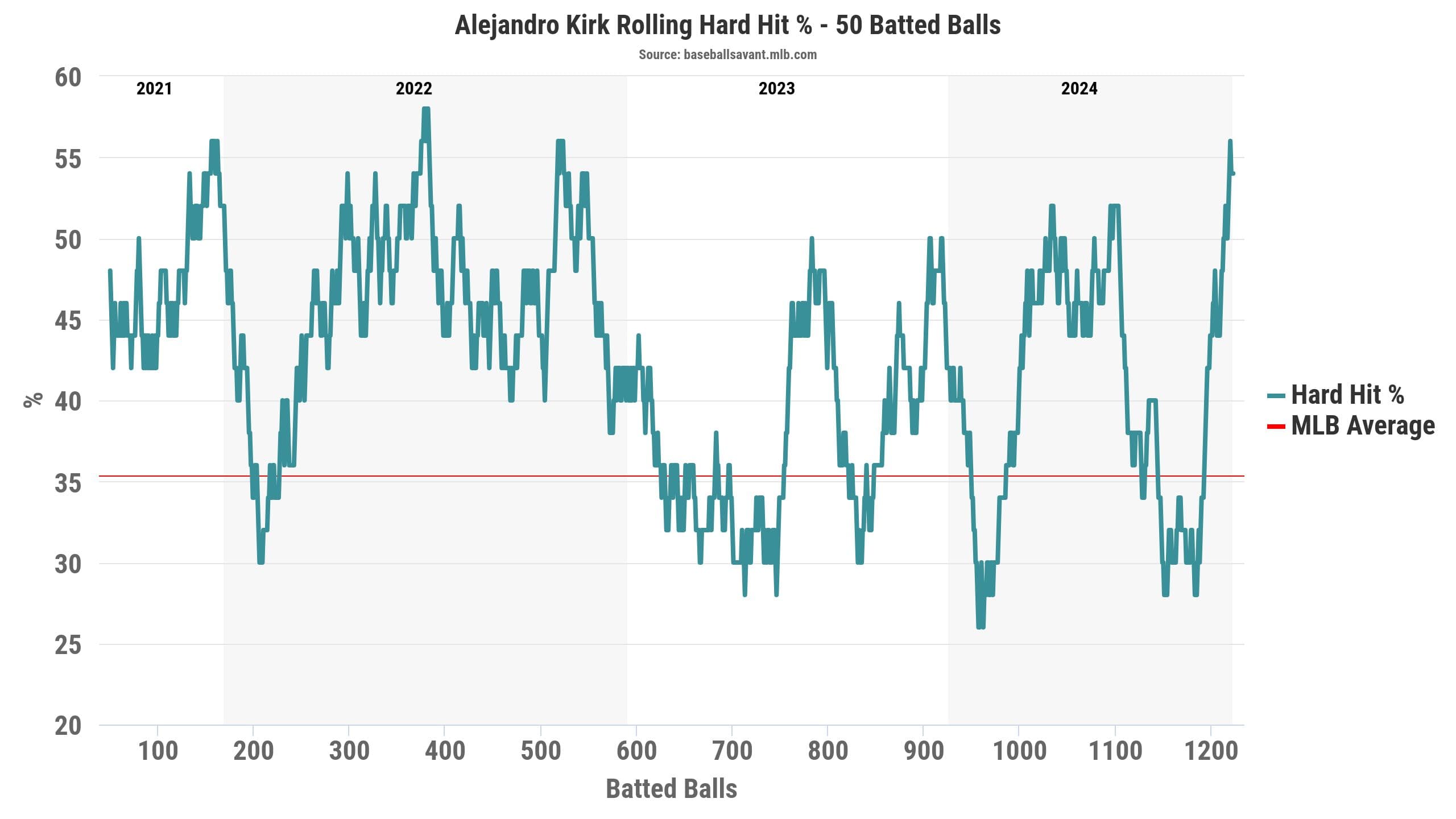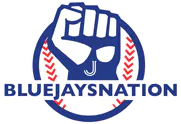Alejandro Kirk leads MLB catchers in pitch framing runs this year and maybe you can see why (these were all called strikes).
Two years away from free agency, Alejandro Kirk will face pivotal test in first season as Blue Jays’ undisputed No. 1 catcher

Photo credit: Dan Hamilton-Imagn Images
By Thomas Hall
Jan 28, 2025, 15:30 ESTUpdated: Jan 28, 2025, 15:17 EST
At this point of the off-season, it’s become clear the Toronto Blue Jays won’t be making a meaningful addition behind the plate before next season. That means Alejandro Kirk will begin the 2025 campaign as the organization’s undisputed No. 1 catcher for the first time in his career.
Things had been trending in that direction all winter as notable catchers from the thin free-agent market came off the board one by one — including former Blue Jay Danny Jansen, who’s now a member of the Tampa Bay Rays, joining his third AL East club. Meanwhile, the only catching additions this team has made thus far have been veterans Christian Bethancourt and Ali Sánchez — both signed to minor-league deals with invites to spring training.
Barring a last-minute addition before camp arrives, and with Tyler Heineman the only other catcher on Toronto’s 40-man roster, the starting job is undoubtedly Kirk’s moving forward.
The Blue Jays brass knows what they have in Kirk — ranks seventh in catcher’s fWAR (9.4) among qualified major-league backstops (min. 500 plate appearances) since 2022 — at least defensively. He’s elite behind the plate, posting the fourth-highest defensive rating (48.9) in the majors over the previous three seasons, thanks to his remarkable pitch-framing and blocking skills.
Since becoming a full-time MLB player in 2022, Kirk has been among the sport’s most effective pitch framers, placing in the 90th percentile or higher with his catcher framing runs in two of the last three seasons. And he’s mirrored that trend with his blocks above average, which peaked in ’23, finishing in the 99th percentile with 14 — second to only Sean Murphy (16).
Despite taking a step back in that department last season, as Kirk’s three blocks above average ranked in the 63rd percentile, the 26-year-old backstop significantly improved in another area: throwing out base stealers.
Prior to ’24, the native of Tijuana, Mexico, hadn’t thrown out more than 15 base runners in a single season. Last season, however, he gunned down a career-high 27 in 87 attempts (31 per cent). Only four other big-league catchers threw out more — Shea Langeliers (29), Logan O’Hoppe (30), Cal Raleigh (32) and Will Smith (32).
Of those 27 who were caught stealing, Kirk recorded seven more than the average catcher would have, producing a 95th percentile for that metric. For reference, the 2022 All-Star hovered around the major league average line during the previous two campaigns, ranking slightly above in ’22 (56th percentile) and well below in ’23 (40th percentile).
Captain's Cannon 💪 @alejandro_kirk
Kirk is as elite as they come regarding defensive catchers, which he’s proven over the last three seasons. But, for as much value as he’s provided Toronto since 2022, several questions remain about the viability of his offensive craft and whether he can be a reliable impact hitter in ’25 and beyond.
Those concerns were largely squashed during his All-Star ’22 performance, where he registered career-highs in home runs (14), RBIs (63), AVG (.285), OBP (.372), wOBA (.347) and wRC+ (129, 100 league average), winning his lone Silver Slugger Award. In the two seasons since then, though, the right-handed-hitting catcher has logged consecutive mediocre offensive showings — at least from an overall standpoint.
The last two seasons have featured plenty of peaks and valleys, although there have been far more low points than highs, considering his production has been five per cent below a league-average hitter per wRC+. Some aspects remained unchanged last season, like his elite-level plate discipline, as his 13.2-per-cent strikeout rate — albeit a career-high — placed among the top five percentile in the majors.
While the rest of Kirk’s results endured a miserable start to 2024, stumbling over the first four months of the schedule, he turned a corner shortly after the Blue Jays traded Jansen to the Boston Red Sox and finished strong down the stretch.
Over his final 42 games, Kirk blasted three home runs — one more than his total from his first 61 contests — and drove in 25 while slashing .270/.341/.405. He also finished with a 116 wRC+, 38 per cent higher versus his score across the first four months of the campaign.
Captain Kirk CRUSHES 🚀 @alejandro_kirk
Even before hitting his stride in early August, Kirk had displayed signs of being close to a breakout dating back to as early as June — even though his traditional results suggested otherwise. He received encouraging spikes involving his balls-in-play output and quality-of-contact metrics, playing integral roles in his eventual offensive resurgence that arrived a few months later.
From June 6 to Aug. 8, only Vladimir Guerrero Jr. carried higher hard-hit (45.6 per cent) and barrel rates (11.1 per cent) on the team than Kirk during that span. The All-Star catcher also enjoyed a considerable boost involving his contact rate (86.8 per cent) over those two months, placing third among Blue Jays hitters with at least 100 plate appearances, trailing only Justin Turner (88.1 per cent) — who was traded to the Seattle Mariners on July 29 — and Ernie Clement (89 per cent).
Additionally, Kirk was one of five qualified major league players (min. 100 plate appearances) to record at least a 45-per-cent hard-hit rate and an 85-per-cent contact rate in that span, joining Carlos Correa, Vinnie Pasquantino, Ryan O’Hearn and rookie Joey Ortiz.
Heading into next season, the Blue Jays will need many more productive stretches like that from Kirk as he embarks on his next challenge as the franchise’s No. 1 catcher in 2025.
Amidst a thin catching pipeline, one without any high-ceiling prospects on the horizon, Toronto is counting on Kirk to deliver an all-around, complete performance in his sixth big-league season — one more in line with his ’22 showing rather than the previous two. They need his hot offensive stretch from last season to carry over into this year.
The Blue Jays can ill-afford a second consecutive slow start from their primary backstop. They desperately need his bat to perform out of the gate, maintaining the consistent levels of hard contact that had him at his best during the ’21 and ’22 seasons.

Source: Baseball Savant
Considering Kirk — a free agent after 2026 — is two seasons away from free agency, whatever performance he delivers in ’25, positive or negative, complete or not, will likely have a massive impact on his contractual future.
Putting together an all-around performance isn’t solely about maximizing this franchise’s playoff odds next season, though that’s a critical piece. It’s also about determining whether the front office has the right person to anchor its catching corps for the next three to five seasons. If not, they’ll have to allocate additional resources towards addressing that position next off-season.
But if Kirk proves otherwise in 2025, it could land him a well-deserved contract extension around this time next year.
Extending the 5-foot-8 catcher would mean buying out free-agent years starting with his age-28 season. However, since he arrived to the big leagues at such a young age, debuting at 21, it’s fairly difficult to locate comparable contracts.
The only other recent examples of catchers signing multi-year deals ahead of their age-28 seasons include Los Angeles’ Will Smith (10 years, $140 million) and Atlanta’s Sean Murphy (six years, $73 million). Of those two, Kirk’s closest comparison is probably with the latter, although even that still feels like apples to oranges to some degree.
Both have posted similar overall value since 2022, as evidenced by Kirk’s 9.4 fWAR rating and Murphy’s 11.0. They also feature comparable wRC+ scores, with the first coming in at 109 and the second at 115. Of course, if not for a forgettable ’24 performance, the Braves catcher would be much farther ahead in both categories after accounting for a combined 124 wRC+ and 10.2 fWAR from 2022-23.
Thus, for Kirk to come close to matching the six-year, $73-million contract that Murphy received from Atlanta a few years ago, he probably needs to enjoy another All-Star-worthy performance at the plate, as well as prove he’s capable of handling an increased workload behind the plate — another critical element that Toronto’s front office must evaluate next season.
An extension almost certainly isn’t front of mind right now, especially with the Blue Jays working on a long-term deal for Guerrero and Bo Bichette’s impending free agency lurking in the background, too. Still, Kirk’s uncertain future beyond 2026 is another intriguing situation worth monitoring as the ’25 season inches closer.
Breaking News
- Michael King re-signs with Padres
- Blue Jays: Gage Stanifer discusses his ‘death ball’ and his rise up the farm system in 2025
- The biggest late-year moves by the Blue Jays in franchise history
- Blue Jays sign Jorge Alcalá to minor league deal
- Blue Jays sign former Pirates catching prospect Geovanny Planchart to minor-league deal
